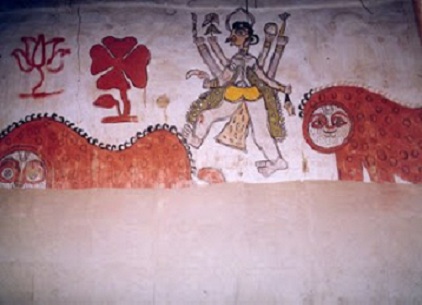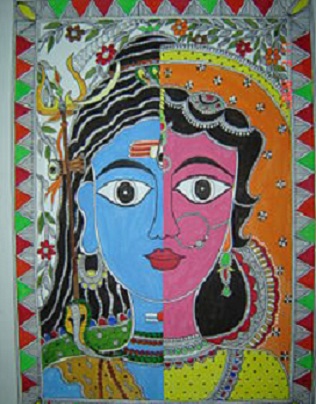Madhubani or Mithila paintings
Indian Folk art
Just imagine a village street with little houses made of mud walls, thatched roofs, lush greenery and cane forests in the background and the walls of those little huts and houses painted in vibrant colorful paintings. That's exactly how the story of Madhubani paintings began.
India has always been rich in art and culture and almost of all of these art forms have withstood the test of time and survived beautifully. The ancient rulers of course encouraged art and all art forms since they loved to surround themselves with beautiful things. Even the tribal people and rural communities who were interested in expressing themselves , in their own humble way took great pains to practice and perfect them. In fact from times immemorial art has always been an essential part of Indian heritage since vedic and ancient times. People belonging to different sections of the ancient population have contributed to make the Indian art form very rich and vibrant.
One can see that even the cave men were interested in expressing themselves by drawing on the walls of caves and tree barks, which goes to show that art is as old as man himself. Folk art or tribal art finds an important place in the art circles of India, as much as that of classical art forms. Tribal art is inspired by nature and the surroundings. People would paint things , mostly every day life as they saw it and how it relates them to nature. They would use the simplest of materials like charcoal or lime stone and paint on the terracotta walls of their humble dwellings. One can see tribal art in all forms in some villages in the states of Bihar, Madhya Pradesh and also Karnataka and Maharashtra. I have visited one such village where every single hut in that little place had some painting or the other and all of them looked good. Some of these tribals are now engaged in painting the road side walls in Bangalore and other major cities in Karnataka with the idea of beautifying them and discourage graffiti.
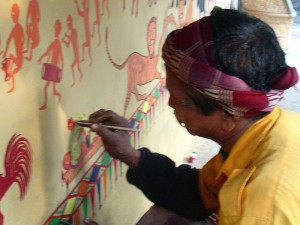
The History and Evolution of Madhubani Paintings
Madhubani painting originated in a little village known as Maithili, situated in the State of Bihar. Although its exact origins are not well known it is believed that like other tribal arts that I mentioned above, Madhubani paintings too began as an everyday drawing that mostly the womenfolk in that region drew on the walls of their home, which were basically as designs of nature, the livestock around them , their thoughts, and their dreams and hopes. Like all art forms these paintings too saw change and evolution with time.
There is also a popular story that is being told in this region , according to which - The paintings originated during the Ramayana period. When king Janak who ruled Mithila decided to marry his daughter Sita to Ram, he is supposed to have asked the people paint the floors and walls of their houses on the occasion of the wedding with vibrant colors and many believe that, it was the beginning.They became popular in the neighboring villages too and became an important and integral part of celebrations and special events, such as wedding, child birth and village festivals. The paintings saw their growth during the times of the British rule who gave all art forms of India a boost by encouraging the artisans by providing them the right atmosphere and also creating a market for them in the outside world.
So, with that Madhubani paintings became popular and well know all over the country and crossed the fixed boundaries, thereby began reaching even the international level. With Independence came self expression and initially during the five year plans some sort of help was given to the folk and tribal arts as well as in the form of forming co operatives from where the small time artistes could get a loan and also sell their art work for a fixed sum. It provided a means of earning for those village women in Bihar and surrounding areas too where it had spread. As of now Madhubani paintings are very well known all over the nation and can be seen in many homes and can be bought on the internet too.
Although it began with mainly women practicing the art of madhubani paintings, later on it became a family tradition with the entire family poling in to make a painting and with this team effort some of them became very detailed and very intricate in detail. Whereas, earlier the canvas was smaller and consisted of deities and figures adopted from nature, now they began to have complicated imaginary drawings of many people and events too pooled together. This of course went on to make the paintings richer and visually much more beautiful.
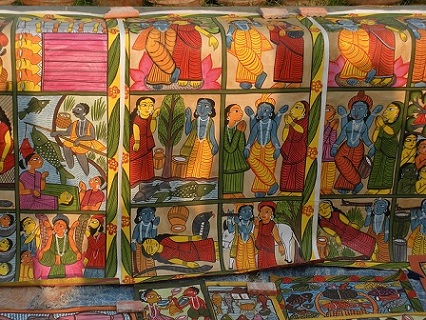
Madhubani paintings are named after the village Madhubani in Bihar where it has its roots. Initially this art form was practiced by women to depict the imaginative scenes and characters from the great epic Ramayana . This was because of the belief that Gods visit each house in the morning, the art form and the pictures were primarily donned the walls and doors, intending to please the visiting Gods. However later the ladies began to experiment and added on more pictures and also color into their paintings. Traditionally it was painted on freshly plastered mud wall of the huts, however later the painters graduated to cloth, Jute , hand-made paper and canvas as well ! With the men folk and others joining in it became a well established family business.
Madhubani painting is also referred to as Mithila Art. As I mentioned earlier it is because of the association of Mithila that the early paintings mostly depicted the scenes from Ramayana. This is an art form that is distinguished by drawings consisting of lines , filled in by vivid colors and patterns. Tribal motifs are also used in the borders and often inter mingled with the main theme of the painting and use of dazzling earthy colors have made these paintings very beautiful..
The many Themes of Madhubani Paintings
Basically, when you look at Madhubani paintings that were done during the good old times , they are two-dimensional and linear works mostly depicting deities , nature and such se themes. But as the art got evolved so did the range and Madhubani paintings now have many wide-ranging themes. Even now the paintings lay importance to drawing and painting scenes from Hindu mythology one can also see that other themes have been evolved around this basic theme.
The most commonly executed themes are of course the events from Ramayana since it began during that period going by the local sources , and also life of Krishna. Lord Krsihna seems to have been a favorite with the Mithila women since there are many paintings depicting his childhood and his various adventures. Other deities too have found a place in the paintings repeatedly. The depiction of Ardhanariswar (Consummation of Shiva and Parvathy ) is considered to be one of the most superior of all paintings of Madhubani because of its detailing. Nature too is given its due importance and there are many paintings that depict the sun and moon and treat them as subjects of holiness, much like the other deities.
Some exceptionally delightful paintings are the ones that are figurative and the secular types. They may not have the rich coloring and known themes like the religious paintings but they are unrivaled in elegance and beauty. As Madhubani paintings evolved and families became part of it, there were many more additions to the themes on which the paintings were done. Many everyday details got added on.
Scenes of rural life also began to be depicted in these paintings. They normally included every day activities in a village life like the women carrying baskets on their heads, drawing water from a well, or a village boy playing a flute , which were all the general themes of these types of paintings .There were also many symbolic paintings that began to flourish in the later periods like the tree of life, sun ,nature and birds depicting a happy and secure life( all is well) and fish which was supposed to be a symptom of fertility were some of the most common symbols of Madhubani art.
Materials that are used in Madhubani Paintings
Earlier women had none of the tools that are seen now so they had to make do with whatever was available to them and they depended on nature to provide them with what was required later modifying them to suit their needs. They made their own tools with plain slatted bamboo sticks that were stuffed with wads of cotton or cotton rags to apply the paint. They would slit bamboos in different widths to get different sizes of lines and some of these old bamboo brushes are on display at some of the art galleries and museums in our country.
The colors that were required were made from vegetable dyes and fruit peels and flowers or at times even natural dye was made by the women themselves using certain root and tree barks. Black dye was made by mixing soot with cow dung, yellow color came from turmeric which is a herb, blue from indigo tree and red from a mix of red sandalwood and turmeric when a shade of orange was required , green color was obtained from leaves and white from rice paste made with ground rice with a little lime added to it to give it depth. Normally the black outlines are drawn first and the color is later filled into the spaces in between and this is time consuming.
The technique of Madhubani Painting
It is but natural that people are interested to know how exactly these paintings are made because of its very humble beginnings and the recent popularity it has gained in art circles. Most Madhubani paintings are marked by abstract figures of deities and bold use of vibrant colors. However there some that are not so colorful keeping to just a 3 or 4 basic colors only. Traditionally, cow dung and mud paste was mixed in equal proportions and smeared on the walls to give it a dark background which got a ethnic look as it dried and matured. On this background the different patterns were painted which included ornate floral patterns, some abstract figures and also borders which incidentally were an integral part of the olden day paintings. White rice paste mixed with lime was used abundantly as also vibrant vegetable colors and dyes made by the ladies.
Later when a variety of synthetic colors were introduced the artists are using their own modern day methods and avoiding the traditional technique of doing Madhubani painting since it was far more elaborate and time consuming..
I am giving here a few steps that are involved in making a Madhubani painting , pertaining to what is being used by artists today.
1. The most important thing is to Select a design, it could be any traditional design or one from the old paintings.
2, Once a design is selected, a sketch is made of the selected design on a trace paper . This can now be copied on to the desired base either cloth or paper with the help of a carbon sheet
3, Once the design has been printed on the base surface double lines are drawn running through the entire picture .
4, Once all the lines are drawn twice including the smaller details, now you need to select the various colors that need to be filled in. These can be filled in tiny straight lines or crosses.
5, Before actually making a Madhubani painting you could practice by creating a simple Madhubani sketch without any color or make a colorful painting using fabric colors on clothes and use poster colors on paper.
6, In Madhubani paintings there is no shading like it is done in other contemporary paintings. The colors are painted flat on to the surface without any shading.
7, Once the painting is done, let it dry completely for 2 or 3 days so that the paints get completely absorbed. Once it is dried to satisfaction, outline the entire design once more with black paint which should stand out and leave it to dry again. Now the painting is once more dried after which it is ready to be framed.
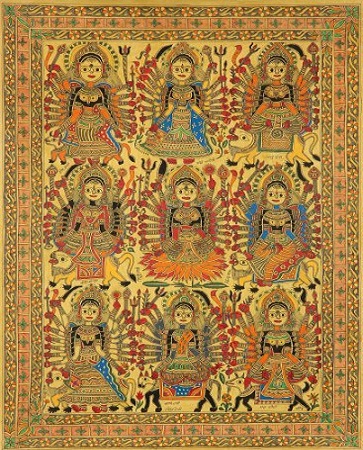
The two predominant styles used in Madhubani paintings are called Kachni style of painting and Barni style of painting.
Kachni is a style of painting where only two colors Black and White are used with strong lines and ,patterns and forms all depicted in these two colors. It is becomig more andmore popular as a simplistic theme among the more upmarket customer who prefer to have zen like appearance where there is more space and a predominantly white background
The Barni style as one can understand from the name itself is more popular with the masses with vibrant colors and ornate borders and mainly depicting deities and also nature and village life. No doubt that these paintings too are equally beautiful and if and when one wisghes to own a Madhubani painting it is a good idea to have one of each.
As things stand today
Madhubani paintings have gone through a lot of changes since their humble beginnings in a village in Bihar, now it is a very big art business. During 1966, the drought which struck the entire area of Bihar and especially Madhubani and the neighboring region of Mithila, left the artisans and the entire rural population hungry since most of them depended on agriculture and were put into great difficulties. The authorities thought that the only way to help them out was by way of creating a new source of non-agricultural income that would help the people keep away from the pangs of hunger.
The All India Handicrafts Board stepped in and encouraged the women artists to create their paintings on handmade paper which was supplied to them along with other requirements and the paintings were used for commercial purposes. For this the work was done on handmade paper or natural fabric like cloth and first treated with cow dung solution to give it its distinctive look and identity. It is like a trade mark for these exclusive paintings. Some of the popular paintings that can be seen in many handicraft centers and art galleries are the original Ramayana scenes, the various adventures of Krishna and nature themes. Now even the depiction of village life and village belles are becoming very popular.
Owning a Madhubani painting is like owning a heirloom that gets passed on to future generations and along with Tanjore paintings which are equally beautiful , and was developed in the Southern part of India, the art scene is complete. The link to my article on Tanjore painting is given below.
http://www.boddunan.com/articles/arts-and-design/235-visual-arts-and-design/20909-article-5.html
Like it on Facebook, Tweet it or share this article on other bookmarking websites.

